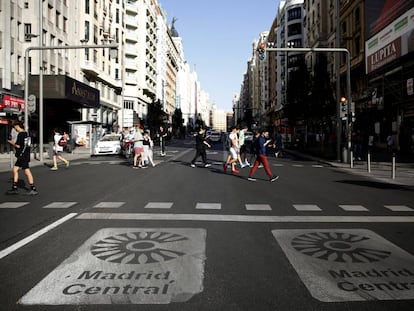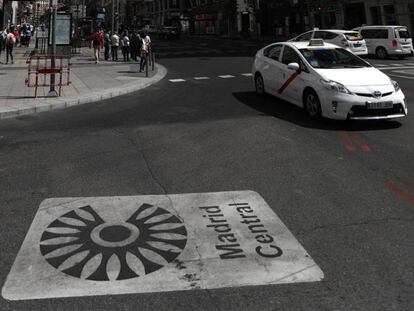Madrid backpedals on bike lanes
While Europe’s major cities are expanding sustainable forms of transportation, the Spanish capital is bucking the trend with plans to eliminate cycling space

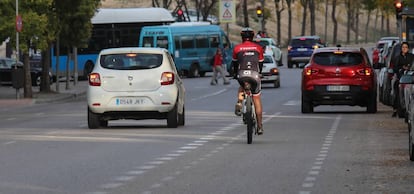
There is a consensus among urban planners and mobility experts that cities should forfeit some of the space used by private motor vehicles to accommodate pedestrians and cyclists, thereby reducing pollution levels.
Taking their opinion on board, most of Europe’s capitals have created a network of cycle lanes in recent years and extended pedestrian zones. Amsterdam, Copenhagen, Seville and more recently London, Paris, Berlin, Barcelona and Valencia are all becoming cycle-friendly, and pedal power is even being championed in cities where the car is king, such as New York, Bogotá and Mexico City.
Given this general trend, it is all the more remarkable that Madrid City Council has declared it is planning to remove a bike lane for the benefit of drivers.
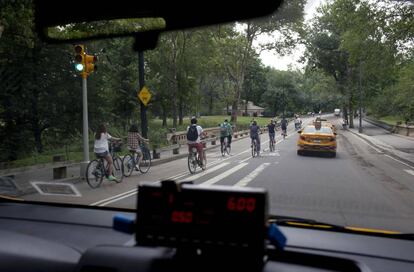
“At this point, it’s very strange to be seeing cycle paths removed in order to reopen lanes for private vehicles,” says Valeria Fedeli, president of the European Urban Research Association, (EURA). “Most mayors across the world are changing their cities to introduce new ways of getting around.”
José María Ezquiaga, the president of the Spanish Association of Urban Technicians, agrees. “The global trend is to reduce the tarmac,” he says. “In order for cycling to be a viable means of transport, it needs to be simple and safe for everyone, which involves creating a network of bike lanes across the entire city.”
According to the Madrid City Council, which is currently controlled by a center-right alliance of the Popular Party (PP) and Ciudadanos (Citizens), the cycle lane that is going to be removed is just 850 meters long and located on the Gran Vía of Madrid’s Hortaleza district, in the north of the city. Created by the former leftist mayor Manuela Carmena, it is a no-car zone although cars must drive across it to reach a number of designated parking spaces. The authorities have justified its removal by arguing that it is generating congestion in the area. “We will return all the lanes that don’t help cycling mobility to their original use,” said Mayor José Luis Martínez Almeida after making the controversial announcement.
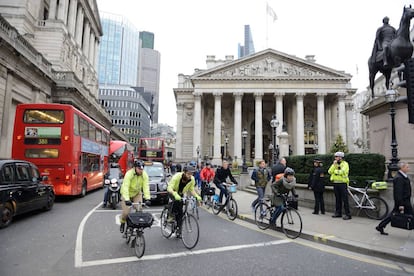
However, when queried by EL PAÍS, city officials were unable to explain the exact criteria for the cycle lane reversal. Almeida and his deputy, Begoña Villacís, first got to work removing the pedestrian zone on Galileo street recently created by the previous administration, and returning it to private vehicles. Now, City Hall is studying the removal of at least two additional cycle lanes.
A city of three million residents, Madrid has just 43 kilometers of lanes reserved for cyclists, some segregated and others defined by lines on the road. Barcelona, which has half the population of the Spanish capital, has a 209-kilometer network. And Seville and Valencia, with populations of 688,000 and 791,000 respectively, have 200 and 150 kilometers’ worth of bike lanes.
But the global trend is not just to extend the number of cycle lanes. It is also to improve existing lanes by physically separating them from the rest of the traffic to make them safer. “London, Berlin and Paris are trading the lanes that are designated with paint for protected ones,” says David Lois, a lecturer at UNED and researcher at the Transportation Research Center at Madrid Polytechnic University.
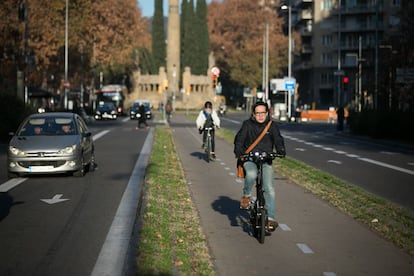
This week, New York City Council announced a $1.7 billion plan that includes the creation of 400 kilometers of protected bike lanes, prompted by the death of 25 cyclists this year. Many New Yorkers have been vociferous in their rejection of bike lanes in the past, arguing that they reduce parking space and affect retail business; in some cases, the authorities have even been taken to court.
“Many studies indicate that cycle lanes benefit the local economy,” says Giuseppe Grezzi, the mobility councilor in Valencia. “We have been criticized but the results have shown us to be right.”
According to Grezzi, in other parts of the world the shift to more sustainable modes of transportation has cut across political persuasions, but in Spain it is viewed as a left-wing policy. He considers the decision in Madrid to be “a step back by the archaic right.”
Esther Anaya, who is researching bicycle mobility at Imperial College, London, is also very critical of Madrid’s regressive move. “Taking this step back is not only embarrassing, it’s also an attack on people’s health,” she says. “We either opt for speed and pollution or for giving this space over to bicycles and pedestrians to promote active and healthy mobility.”
But it is not enough to just paint the lines of the bike lane on the road. Easier to ignore, lanes of this kind put the lives of cyclists in jeopardy. “We are against getting rid of cycle lanes in any Spanish city, and support the construction of protected lanes to improve cyclist safety,” says Nacho Tomás, secretary of the association Red de Ciudades por la Bicicleta (City Network for Bicycles), which encompasses more than 100 towns and cities across Spain, including Madrid.
“Madrid is the only city in the world that has thought of getting rid of cycle lanes,”says Niccolo Panozzo, spokesman for the European Cyclists Federation (ECF). From Portland to Bogotá and Singapore to Tel Aviv, every other city is moving in the opposite direction, he adds.
Pedal power from Paris to New York
Barcelona. The Catalan capital has 209 kilometers of cycle lanes, almost all of which are physically separated from motor vehicle traffic, and half of which have been created in the last eight years. "Several cycle routes have been improved by changing their location – either shifting them from the sidewalk to the roadway or making them wider to improve safety," says mobility councilor Rosa Alarcón.
New York. The bicycle is central to a two-pronged mobility and sustainability strategy in New York, a city that has long been choked with motor vehicles. During the last 20 years, the network of cycle lanes has gradually expanded and now covers almost 2,000 kilometers. An average of 100 kilometers of cycle lanes a year have been added over the last three years, according to the Department of Transportation. There is also a shared bike scheme known as CitiBike that was launched in 2013.
Paris. The mayor of Paris, Anne Hidalgo, is keenly pro-bike and next year she aims to start work on 1,000 kilometers of cycle lanes to double the existing number and create a network that will allow people on bikes to feel safe across the city. She is also establishing several pedestrian zones.
London. The UK capital has around 100 kilometers of cycle paths in the city center and others that are marked but shared with cars. However, an ambitious plan is afoot to create 450 kilometers of cycle superhighways by 2020 to link the outskirts with the city center and make sure that 28% of Londoners have a cycle path not further than 400 meters from their home.
Valencia. The city has 156 kilometers of cycle lanes and next week another 2.4 kilometers are being inaugurated in Primado de Reig. Since the five-kilometer cycling ring route was established in 2017, more than three million cyclists have used it.
Berlin. The German city has around 1,000 kilometers of cycle paths. The mobility law passed last year now stipulates that all the main streets in Berlin must have one.
Amsterdam. Considered the world capital of cycling, Amsterdam has 767 kilometers of cycle routes and 10,000 parking spots for bikes. A new initiative aims to get rid of 11,200 parking spaces for private vehicles by 2025 in order to make the city more pedestrian-friendly.
Rome. The city has a total of 242 kilometers of cycle paths – 142 along the streets and the rest in parks. Recently, new routes have been set up and 15 kilometers of lanes are currently being planned or under construction.
Madrid. The Spanish capital has just 43 kilometers of cycle lanes, including some physically separated from motor vehicle traffic and others simply marked with paint. It is the only city to be dismantling existing lanes rather than creating new ones.
With reporting by Clara Blanchar, Sandro Pozzi, Daniel Verdú and Enrique Müller.
English version by Heather Galloway.
Tu suscripción se está usando en otro dispositivo
¿Quieres añadir otro usuario a tu suscripción?
Si continúas leyendo en este dispositivo, no se podrá leer en el otro.
FlechaTu suscripción se está usando en otro dispositivo y solo puedes acceder a EL PAÍS desde un dispositivo a la vez.
Si quieres compartir tu cuenta, cambia tu suscripción a la modalidad Premium, así podrás añadir otro usuario. Cada uno accederá con su propia cuenta de email, lo que os permitirá personalizar vuestra experiencia en EL PAÍS.
¿Tienes una suscripción de empresa? Accede aquí para contratar más cuentas.
En el caso de no saber quién está usando tu cuenta, te recomendamos cambiar tu contraseña aquí.
Si decides continuar compartiendo tu cuenta, este mensaje se mostrará en tu dispositivo y en el de la otra persona que está usando tu cuenta de forma indefinida, afectando a tu experiencia de lectura. Puedes consultar aquí los términos y condiciones de la suscripción digital.
More information
Archived In
Últimas noticias
Mexico seeks to shore up its defenses following US incursion in Venezuela
Hope gives way to uncertainty among Venezuelan exiles in the US after Maduro’s capture
Cubans look to Venezuela fearfully after Trump’s incursion: ‘We could be next’
The operation in Venezuela to capture Maduro threatens to widen the cracks in the MAGA movement
Most viewed
- Alain Aspect, Nobel laureate in physics: ‘Einstein was so smart that he would have had to recognize quantum entanglement’
- Gilles Lipovetsky: ‘If you want to live better and fall in love, take Prozac, don’t look to philosophy’
- Alvin Hellerstein, a 92-year-old judge appointed by Bill Clinton, to preside over Maduro’s trial in New York
- Cuba confirms death of 32 of its citizens in the US attack against Venezuela
- Why oil has been at the center of Venezuela-US conflicts for decades
